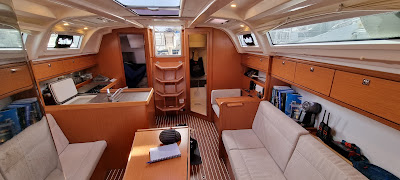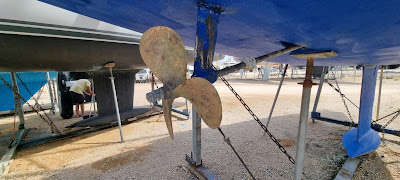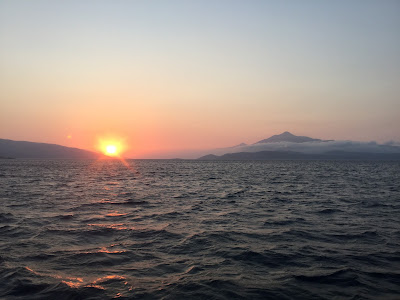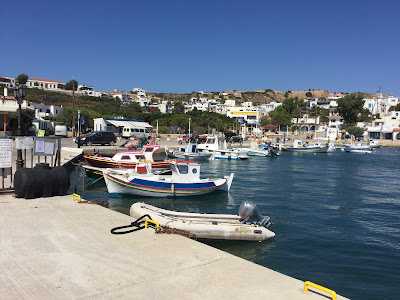Welcome! I have been surveying boats since 1995, and by 2025, I have completed over 3850 surveys, encompassing a wide range of sail and power boats. Email me: Steve Truss at: steventruss1@aol.com. What can I help you with?
Thinking about buying or insuring a boat in Preveza Greece??
Saturday, 6 April 2024
2019 Bavaria Cruiser 37 for sale / marine survey in Preveza
Saturday, 9 March 2024
Today's survey assignment involved conducting a Pre-Purchase Inspection and Valuation of a popular Lagoon multihull, constructed in 2013, Preveza
Surprisingly, we discovered no issues with the bulkheads or any structural problems whatsoever. Clearly, this vessel has been well-maintained.
Lagoon catamarans are well-known in the sailing community for their comfort and space, offering a popular choice for both private use and charter operations. However, like any mass-produced boat, they have faced scrutiny over certain design and construction issues, notably concerning structural problems related to bulkheads and door frames. These issues are important to consider for potential buyers and owners in the context of ensuring the safety and longevity of their vessel.
Bulkheads in any sailing vessel play a critical role in the overall structural integrity. They are essentially the vertical walls within the hull that divide the boat into different sections. In addition to compartmentalization, bulkheads provide crucial support to the hull, reducing flex and helping to distribute stresses experienced while under sail or in rough conditions. In Lagoon catamarans, there have been reports and instances where the bulkheads have either been inadequately bonded to the hull and deck or have shown signs of detachment over time. This detachment can compromise the boat's structural integrity, leading to increased flexing of the hull, which can exacerbate the issue or lead to further damage.
Similarly, door frames within these catamarans can also present problems, particularly if the hull and deck begin to flex more than anticipated. This flexing can lead to misalignment of door frames, making doors difficult to close or, in some cases, causing them to become jammed. This is not just an inconvenience but also an indicator of potential structural movement or deformation.
The underlying causes of these issues can vary, including design considerations, construction methods, materials used, and the quality control processes in place during manufacture. For potential buyers or current owners, it's essential to conduct a thorough survey of the vessel, with a particular focus on these known areas of concern. A qualified marine surveyor, familiar with Lagoon catamarans and the specific standards outlined by The Boat Safety Scheme and the International Institute of Marine Surveying, should inspect the vessel. This inspection should aim to identify any signs of bulkhead or door frame issues, assess the severity, and recommend any necessary remedial actions.
Addressing these issues early can prevent more significant problems down the line, ensuring the safety of those on board and protecting the investment in the vessel. It's also worth noting that while these issues have been reported, many Lagoon catamarans sail without incident, testament to the model's design and the joy it brings to its owners. However, awareness and vigilance regarding these potential structural problems are key to a positive ownership experience.
Saturday, 10 February 2024
List of Marine Surveyors working in Preveza, Greece
Finding the Perfect Yacht Overseas: The Essential Step Before Making an Offer
Imagine this: After hours, days, or even weeks of research, you've finally stumbled upon the perfect yacht online. It's a beauty, nestled in the picturesque marina of Preveza, Greece. But there's a catch - you're in the USA, and the yacht is thousands of miles away. You're ready to make an offer, but how can you ensure that the yacht is in pristine condition as described? Enter the marine surveyor.
 |
Hello, I am Steve Truss, a UK-qualified IIMS Yacht Surveyor with over 25 years of experience in the field. If you're considering a yacht purchase in Preveza, I'm here to guide you through the essential step before making an offer: a professional yacht inspection.
Why is a Marine Survey Important?
Buying a yacht is a significant investment, and the last thing you'd want is to discover hidden defects or damages after the purchase. A marine surveyor provides an impartial assessment of the yacht's condition, giving you peace of mind and vital information to make an informed decision.
What Can You Expect from the Survey?
When you hire me to inspect the yacht in Preveza, here's what you can anticipate:
Thorough Inspection: From the yacht's hull to its internal systems, I will comprehensively assess every aspect, ensuring there are no hidden defects.
Detailed Report: After the inspection, you will receive a detailed report highlighting the yacht's condition, its valuation, and any recommended repairs.
Negotiation Leverage: The findings can be invaluable in negotiations. If there are any repair requirements, you can either request the seller to address them or renegotiate the price.
How to Proceed?
If you've found a yacht in Preveza and need a reliable marine surveyor, here's what you should do next:
Contact Me: Reach out to me with details about the yacht you're interested in. I'll provide you with an initial consultation and an overview of the surveying process.
Schedule the Survey: Once everything is clear, we'll fix a date and time for the survey. I'll coordinate with the seller or the local agent to ensure a seamless process.
Review the Report: After the inspection, I'll provide you with the comprehensive report, which will be your key tool in deciding your next steps.
Purchasing a yacht overseas can be a daunting process, but with the right assistance, it becomes a lot smoother. Let my 25 years of experience in yacht surveying serve as your guide and assurance. With me, you can rest easy knowing that your dream yacht in Preveza is precisely what you've envisioned.
Dream of cruising in your perfect yacht? Don't let the distance deter you. Make an informed decision with a trusted marine surveyor by your side.
Sunday, 24 September 2023
With the yacht safely ashore, the marine survey could begin in earnest. Every inch of the vessel was inspected – from the hull's condition to the integrity of the rigging, and from the engines to the electrical systems. The interior received a thorough examination as well, ensuring that all systems were in perfect working order.
Saturday, 23 September 2023
"Navigating Success: A Marine Survey of the Jeanneau Sun Odyssey 37"
The Jeanneau Sun Odyssey 37 has long been known for its sleek design, reliable performance, and comfortable cruising capabilities. For any boat owner or prospective buyer, a thorough marine survey is a critical step to ensure the vessel's structural integrity and overall condition. In this blog post, we'll take you through a successful marine survey conducted on a Jeanneau Yacht, highlighting its structural condition and well-maintained state.
Preparation and Inspection
Before embarking on the survey, it's essential to prepare a checklist of key areas to inspect. The surveyor typically begins with a thorough examination of the yacht's exterior and interior, checking for any visible signs of damage or wear.
Structural Integrity
One of the first aspects examined during the survey is the hull's structural integrity. The surveyor checks for any signs of osmotic blistering, which can indicate issues with the fiberglass. In the case of this particular Jeanneau 37, the hull was found to be in excellent condition, with no signs of blistering or significant damage.
The deck and superstructure are also crucial areas for inspection. The surveyor checks for any soft spots or delamination, which can be early signs of core material damage. Again, this Jeanneau Sun Odyssey passed this examination with flying colors, as the deck and superstructure were solid and showed no signs of moisture intrusion.
Sails and Rigging
Moving onto the sails and rigging, a surveyor assesses their overall condition, looking for any tears, fraying, or signs of rust or corrosion. Proper maintenance and care were evident in the examined Jeanneau 37, with the sails and rigging in great shape. This is a testament to the owner's commitment to keeping the yacht in top-notch condition.
Interior Condition
The interior of a yacht is just as important as its exterior. A marine survey includes a thorough inspection of the cabin, looking for signs of water intrusion, mold, or structural issues. This Jeanneaus interior was found to be clean, dry, and well-maintained, with no signs of significant wear or damage.
Mechanical and Electrical Systems
A comprehensive marine survey also delves into the yacht's mechanical and electrical systems. This includes checking the engine's condition, plumbing, and electrical components. In the case of this yacht, all systems were in great shape, demonstrating the owner's commitment to regular maintenance.
Conclusion
In conclusion, the marine survey revealed a yacht in a good structural condition and well-maintained throughout.
If you're in the market for a sailboat that combines performance, comfort, and structural reliability, the Jeanneau Sun Odyssey 37 is undoubtedly a noteworthy choice. This marine survey reinforces its reputation as a solid and well-crafted vessel ready for countless adventures on the open seas.
"I'm here to assist you with any type of yacht inspection survey you may need. Feel free to ask any questions or seek guidance on assessing the condition and suitability of your chosen yacht for your specific needs."
Monday, 10 July 2023
7 Checks after grounding a yacht!
As a marine surveyor, I’ve seen a huge range of yachts that have suffered groundings of variable severity. Sometimes the damage is obvious and it’s clear that repairs are needed. Sometimes, though, the damage is more subtle, but no less dangerous. Skippers who aren’t aware of what to look for have sailed on for months with their boat in a precarious condition.
With this in mind, I’ve put together a quick list of areas to check if you ever touch the bottom yourself in a GRP yacht. It’s not an exhaustive list, but hopefully it will give a good overview of areas that need attention. These checks can be useful, too, for those in the market for a used yacht. Sometimes sellers are not aware of the damage themselves.
KEEL: Owners are often lulled into a false sense of security if they’ve gone aground lightly on sand. However, sand underwater is like concrete. They might have been sailing at only 5-6 knots, but the tidal stream rate, wave height and angle of heel all play a big role in how the craft fares. I’ve seen the aft edge of a lead keel bent into an S-shape after a yacht has grounded when virtually upright. If you haul out, check for this by laying a straight edge along the aft edge. In professional hands, many lead keels can be straightened. With cast iron keels, the impact is not absorbed so well through the keel. Check for signs of stress crazing around the gelcoat where the keel joins the hull. Trouble spots at the front and rear of the keel are often easiest to find. On removal of the gelcoat, you’ll often find the hull’s reinforcement material is compromised. Due to the nature of gelcoat, hairline cracks take time to become visible to the eye, so periodic checks are vital. If damage has been found, it is prudent to remove the keel. With bilge-keelers, even if there is no damage internally, I’ve seen instances where the keels have splayed apart, bending the studs. This sort of damage needs to be assessed out of the water.
Look at the condition of the keel studs and check for any weeping. On some craft the first bolt and the aft stud are a smaller gauge, to reduce the chance of splitting the casting. This can result in the material being stretched. Also look for ‘tea-stains’ around the fastenings, a sure sign of water ingress. Don’t feel frightened to ring the studs with a hammer. If you do this on a regular basis, you will soon know when there is a problem – a dull sound often confirms the worst.
KEEL STUDS: Lots of boats built in the 1970s and 1980s have encapsulated ballast, where the keel is part of the hull moulding. The GRP fin contains steel punchings (the pellet of steel that is left after punching out the centre of a washer) and no bolts or studs. I’ve found these to be very strong and you only need to ensure the GRP casing is not compromised, leaving the punchings open to potential rusting.
SOLE BOARDS: After any grounding, I always recommend removal of the sole boards above the keel. This may require some careful work with a screwdriver, but once the boards are up, check the whole area for stress cracks and any detachment of items bonded in. On fin-keeled boats built since the mid-1980s, which are more likely to have a hollow-core matrix bonded in to provide support, it’s important to check right back under the engine bed.
SKIN FITTINGS: Grounding a twin-skinned hull could result in the skin fitting collar being stretched.
A bigger problem can be detachment of the inner skin moulding from the outer hull where the bonding has failed.
BULKHEADS: Bulkheads add rigidity to a hull but can also cause damage in a grounding. If the bulkhead has been bonded in tightly, it can produce a line of stress on both sides of the craft. On some boats, I’ve seen this spread up the side of the hull and across the deck moulding too. Bulkheads can also become detached. Most grounding force seems to push the back end of the keel casting upwards, which on traditionally laid-out craft is in line with the chart table and galley. Look in lockers, cupboards and under the chart table for detachment. On boats built before the mid-1980s, check for detachment of the floors, where they are bonded into the hull. I once found a Rival 34 where the floors had completely detached, allowing the hull to twist.
RUDDER: I’ve seen the pintles of transom-hung rudders stretched or bent and fittings pulled right through the transom. However, less obvious is when they are just weakened. Again, look for gelcoat crazing around the fittings. If the rudder stock is housed within a tube, check the bonding of the tube into the hull and the gland or method of sealing. Many new production craft use lip seals. Normally, lip seals are reliable, but if the rudder blade is forced upwards they can become dislodged and then leak when the stock is turned.
CONCLUSION: Some East Coast sailors bump their keels almost every time they go sailing and think nothing of it unless the tide’s falling. Similarly, bilge-keelers nearly always bump a bit as they take the ground. In both of these cases, personal experience is the key to knowing when you need to check for damage. Generally, though, I would advise never to underestimate the smallest of accidental groundings. At the very least, check properly in the bilges for the slightest clue that there is a problem – even minor weeping around the fastenings is a clear giveaway. And remember that gelcoat stresses don’t always show immediately, so periodic checks are important.
If anything looks suspect, get the boat out the water at once and contact your insurance company, which should have experienced staff to deal with this type of claim and in most cases will appoint a qualified surveyor to report the extent of the damage.
Article written by Marine Surveyor
Wednesday, 4 May 2022
Athens Yacht and Marine Surveyors
I am a long established independent UK Yacht and Marine Surveyor based near Athens Greece, specialising in the field of yacht surveying and consultation. I have been Marine Surveying boats since 1995. By 2022 I have completed over 3700 surveys, which have included 100's of types of sail and power boats. I carry professional indemnity insurance cover and I have been a member of the International Institute of Marine Surveying for over 20 years. We provide a range of Marine Surveys including Pre-Purchase Surveys, Hull Surveys, Systems Surveys, Sea Trials, Insurance Surveys, Damage Surveys, Valuation Reports and Finance Surveys.
With many years of experience representing interests of both Purchaser and Vendor, we are fully aware of the problems which may arise in the process of purchasing a vessel.
If your looking for Yacht Surveys in Athens, Preveza, Lefkada, Leros Nidri or any other location please drop me an email to steventruss1@aol.com
Sunday, 17 April 2022
I am back working in Preveza and Lefkada carrying out a number of Pre-Purchase and Insurance Surveys from May the 5th 2022 and will probably be in the area for two weeks, so if I can help you with an Inspection and Valuation on a Yacht you are interested please drop me an email at steventruss1@aol.com
Check out my options when deciding on a type of Survey.....
Saturday, 11 September 2021
UK Marine Surveyor and Consultant operating in Greece
Another trip to Lipsi this week before preparing for our month in Preveza. We already have a Broadblue Catamaran booked and a 24m wooden Gulet in Lefkada. Plenty of spaces left so if you have your eye on a Yacht in the Ionian islands, Preveza, Lefkada or Nidri drop me a message today at steventruss1@aol.com
Lipsi is a small group of islets at the northern part of the Dodecanese near to Patmos island and Leros.
If you travel from Rhodes or Kos you can use on daily basis the Catamaran Dodekanissos. Lipsi does not have daily connections with ferries from Athens Greece so you can get there either from Patmos or Leros. During the summer there is once a week connection with the Cyclades island of Mykonos with the ferry boat Milena from Leros.
 |
 |
| Has to be done! |
Tuesday, 24 August 2021
What is a Pre- Purchase Marine Survey?
This comprehensive inspection is strongly advised when purchasing a new or used vessel. The purpose of this marine survey is to provide the buyer with the necessary tools to make informed and balanced decisions regarding the vessel and to evaluate its general condition and overall operation prior to purchase.
The pre-purchase marine survey report is specifically tailored to provide a clear and realistic assessment of the vessel. It includes a detailed breakdown of recommendations made by the marine surveyor, which are clearly graded as being essential, recommended or advisory. This can be a useful tool to negotiate specific repairs or price adjustments with the vendor as well as serving as a maintenance and repair checklist post purchase.
Please email me for a sample Marine
Survey Report
This marine survey can also include a sea trial and the buyer is strongly encouraged to attend. At the conclusion of the inspection, a debrief is conducted by the marine surveyor to go over the findings and to answer any questions whilst still aboard the vessel.
The scope of this marine survey includes, but is not restricted to, the following principal areas:
Identifying the vessel and its major components by using hull, registration and serial numbers where available.
Identifying any defects, damage and previous repairs where visible by non destructive methods.
Evaluating the structural integrity of the hull (internal and exterior), deck and superstructure.
Reporting on the condition of the mast spars and rigging from deck level using binoculars.
Sails will be raised and unfurled during sea trial, any sails bagged below may be inspected ashore if conditions are suitable
Reporting on the machinery installation and the condition of the engine(s) as far as can be ascertained from their operation during sea trial and basin tests.
Report on the installation of the fuel, LPG and water systems including tankage and plumbing.
Report on the electrical installation and operation, both AC and DC.
Report on the Navigation systems and their operation as far as is practicable.
Fire and safety equipment are checked.
























.jpg)









